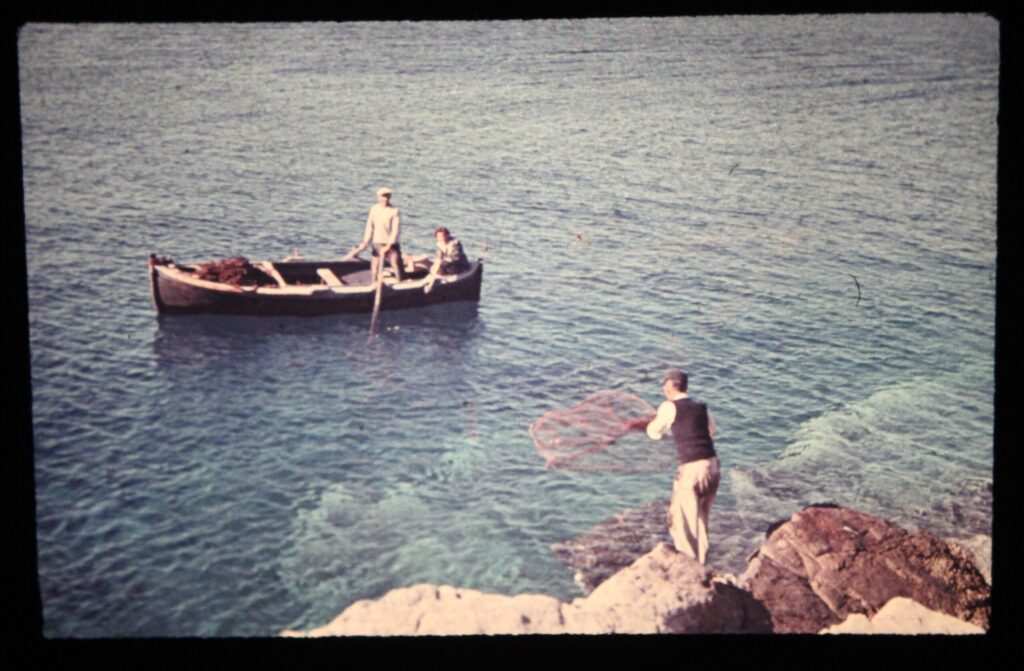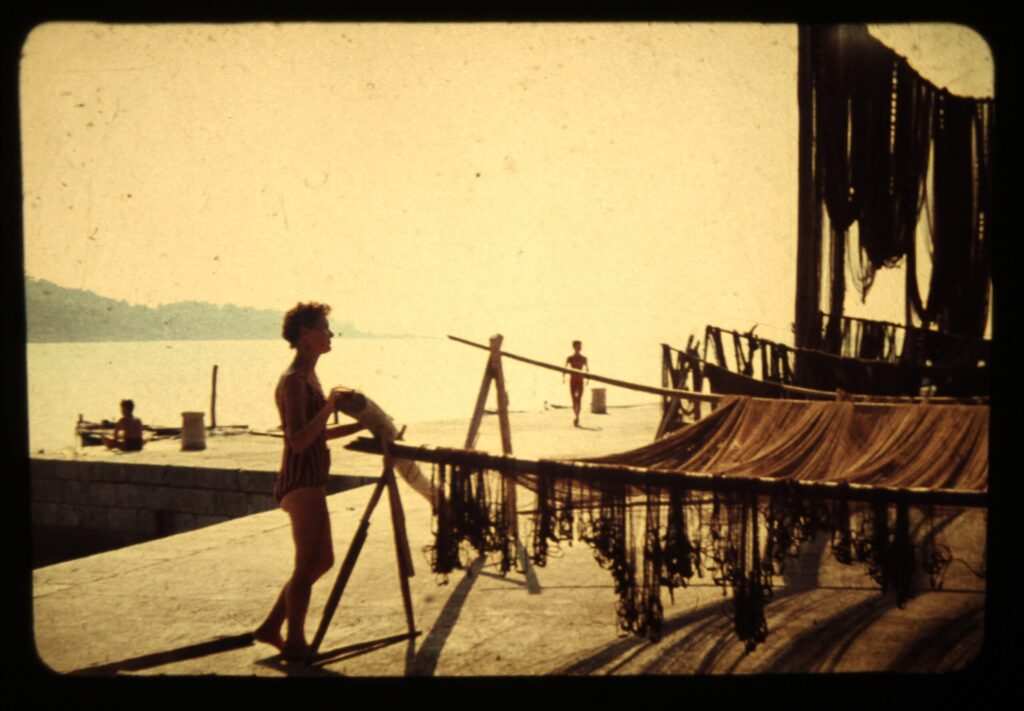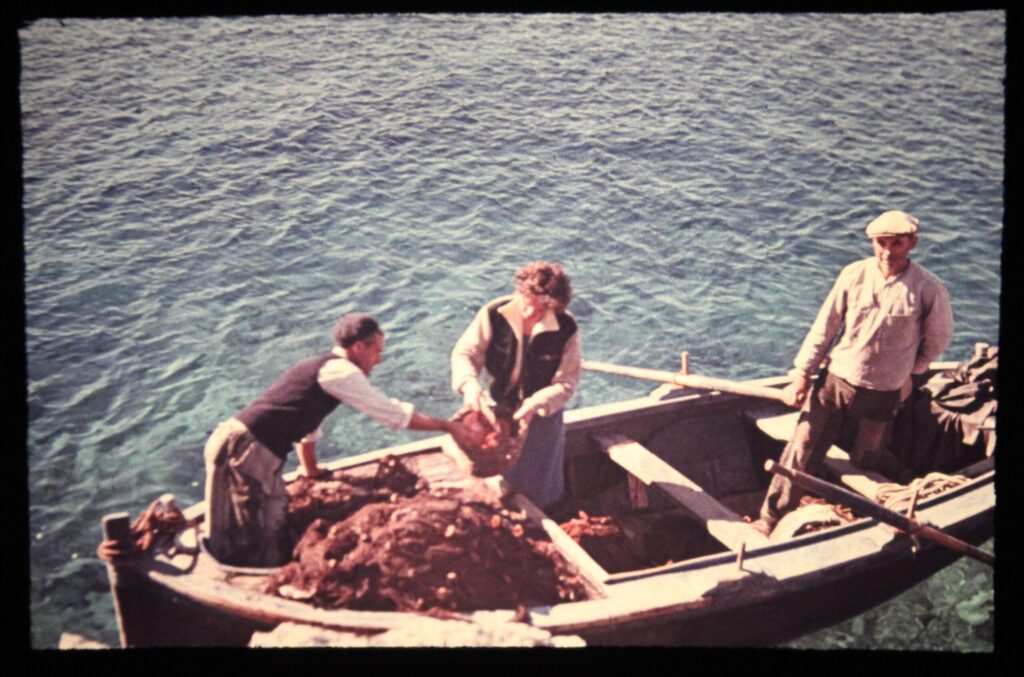Before morning the fishermen wake up, the sea knows them, the sea knows these people… Although the sea knows these people, fewer and fewer of us can count the fishermen of this area, which is confirmed by our storyteller from Cavtat: Cavtat is becoming a tourist destination and there are less and less professional fishermen with these tools where they are sufficient as individuals with professional equipment, for example they can be standing nets, longlines, various types of nets…
Thinking about how the number of fishermen is decreasing, or at least those older ones who know the local expressions, we went right to the bone or the end, i.e., the coast, to record at least some terms that belong to the Cavtat fishing dialect.
For beginners, the standard term žalo or žal (beach in English) in Cavtat dialect is žo, and the narrow passage between an island and the coast or between two islands is kono (canal). The people of Cavtat will say that they were in the konal or that they have thrown nets into the kono. The same word on Šipan and Mljet is ždrijelo, and in Molunat it is vratlo. The people of Cavtat will sometimes say that they are in the vratlo (canal) of Mrkan island. Many fishing expressions vary from place to place, from minor differences such as orhan (amberjack) in Cavtat is called orfan in Molunat, to the crevice or undercut in the cliff, which in Cavtat is called škrip, and on Mljet is known as garma. The swimmers’ not-so-favourite grassy seabed is called voga, while the sandy seabed is called fanag.
As most local people know, when the sea is completely calm, it is called bonaca, and in Cavtat bunaca or kalma. A sudden storm is called a skontradura, so when the weather turns abruptly, we will say that it has skontralo. A layer of storm clouds is called a kalada. When we see the kalada, or if God forbid it lightens (zalampa), we will see at sea how the boats are accelerating (verb = abrivati). Soon they will land (verb = akostati), come to the end, dock – either in the luka (port), portić (small closed port), mandrač (bay) or gamboč (small port).
Well, small natural coves are also called that – go earlier to take the portić on Mrkan, the Portić of Laurel, and there is also a Skewer from Bobara… The skewer (ražnjić) is so-called because it has a lot of ridges, stones, and they are arranged like on a stick, on the horizon…
If the boat is immersed, that is, loaded on the bow, it is improvana, and if it is immersed in the stern, then it is inkrmana. There is also a fishing term when a fish gets stuck in a net – inčeta, and it can be the case in many fishing nets: srdelare or floating nets for sardines, šabake, these are tugs, then migavice, nets with a bigger eye down at the bottom, for catching bigger blue fish like amberjack, mreža trakta, potegača, plivarica that is for smaller fish and so on. That is why there is a verb dečetati meaning – to weave a fish out of a net.
Although Cavtat is becoming more and more a tourist place, some of the principles of fishing as well as the rules in the distribution of catches remain the same today. So, in joint fishing, the fishing leader – the one who says where and how the net will be thrown, and who is also the owner of the boat, net and other equipment – is called the patrun. The patrun is the one who bears the cost of the marenda (snack): a bottle of wine, a loaf of bread and some sardines to eat, and other fishermen who work for him are called drugovi (comrades). In the distribution of the catch, the patrun is counted as a drug, so the catch is divided – whether it is money or in kind – so that half of the catch belongs to the ship and tools, and the other half is divided evenly by the number of comrades, including the owner. So, if the patrun had one drug, the other will get ¼ of the catch, and the patrun the rest. Although it may sound unusual at first, it should be borne in mind that the owner is the one who bears all the costs of fishing, if the net breaks, the engine breaks down…
We also know of gaff fishing with candlelight which in Cavtat is called dokes. A svjećarica is a ship that carries light, there is a main light that stays and one that goes out, it is that larger boat on which the net is. It is usually done with two lanterns, the svjećarica is the one that stays last while the fish is still being held, and the net is surrounded, enclosing the fish. A fisherman looking for a fish under a svjećarica is called a svjećar.
Today, fish is counted by kašete, that is, crates, and once it was counted by barjeli, bačve, barrels. If we continue with Cavtat’s fishing expressions, we must also mention the điga, the wall along the pier or breakwater, as well as the boat mooring pole called the kòlona, and the underwater cliff rich in fish is called seka or lenga. The place where the nets get stuck is called zadjev or, again seka. Profundis is an underwater abyss, a place where the sea floor suddenly collapses.
When we dive into the marine flora and fauna, we would delve into an almost infinite number of names, so we will not dare to dive so deep, we will mention only fish from ašprin or kamen (stone) and those from fango (sandy bed) or mud. Then pȅna, a small shark without bones in its dorsal fin and kučak or kostelja (bone), a shark with bones in its fins. Fear not, they are usually in the deeper sea, and the collective name for sharks, cats and rays is divljač (game) ili lantrovina. On the other hand, the old fishermen collectively called all those little fish čemadjeji – Even if you want something for soup, you have more bones than meat.
We won’t bother you with carpenter’s details, but we would like to quickly mention the main expressions: the deck is called a kuvjerta, the draft is peškadura, and the protective lath under the keel is a kontrakolumba or šoleta. The rib of the boat is called the korba, the verđine keep the ribs at the bottom to be together, and at the top there is a pojas or faša… Madijeri are tied to the ribs, razma is the board that frames the deck, and the servadura is the curvature of the deck in the stern-bow direction. The mentioned kontrakolumba or šoleta is smeared with a special paint so that the worm or the beetle does not enter, because if it enters the bridge and that bridge breaks up, you have nothing to tie yourself to… And if the heart of the boat is bent…
And lastly, you don’t need a buc or bucalo (a stick used to scare fish) to chase us like fishermen chase fish with rods across the sea, we know when enough is enough. Therefore, we have prepared the take, beams for pulling out and launching the boat, so we give you our regards until your next departure.



